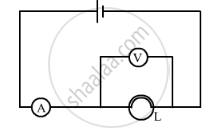Advertisements
Advertisements
Question
The diagram below shows a circuit containing a lamp L, a voltmeter and an ammeter,. The voltmeter reading 3 V and the ammeter reading is 0.5 A.

What is the resistance of the lamp?
What is the power of the lamp?
Solution
Given:
Potential difference = reading of the voltmeter, V = 3 V
Current in the circuit = reading of the ammeter, I= 0.5 A
(i) Resistance of the lamp, `R=V/I=(3V)/0.54=6 ohm`
(ii) Power, P = VI = 3 V x 0.5 A = 1.5 W
APPEARS IN
RELATED QUESTIONS
At what frequency is AC supplied to residential houses?
An electric kettle connected to the 230 V mains supply draws a current of 10 A. Calculate:
(a) the power of the kettle.
(b) the energy transferred in 1 minute.
How many joules are there in one kilowatt-hour?
Why is an electric light bulb not filled with air? Explain why argon or nitrogen is filled in an electric bulb.
A bulb of 40 W is used for 12.5 h each day for 30 days. Calculate the electrical energy consumed.
State the S.I. units of electrical power and electrical energy.
(i) Define the household unit of electricity.
(ii) What is the voltage of the electricity that is generally supplied to a house?
An electric bulb of resistance 500 Ω draws current 0.4 A from the source. Calculate:
- the power of bulb and
- the potential difference at its end.
Why is heating coil wound in the form of a helix in electric stove?
Why is heating element wound on a long porcelain rod in a room heater.
An Electric bulb is marked 100 W, 230 V. What find the energy consumed by the bulb in one hour.
